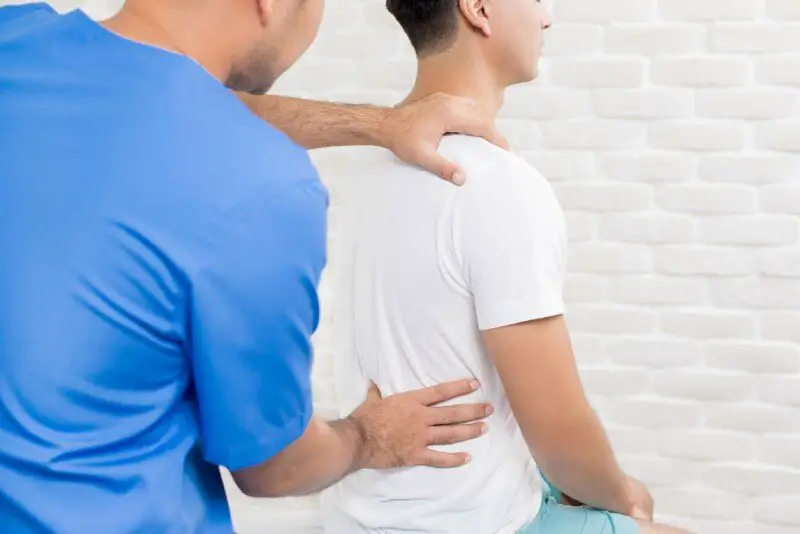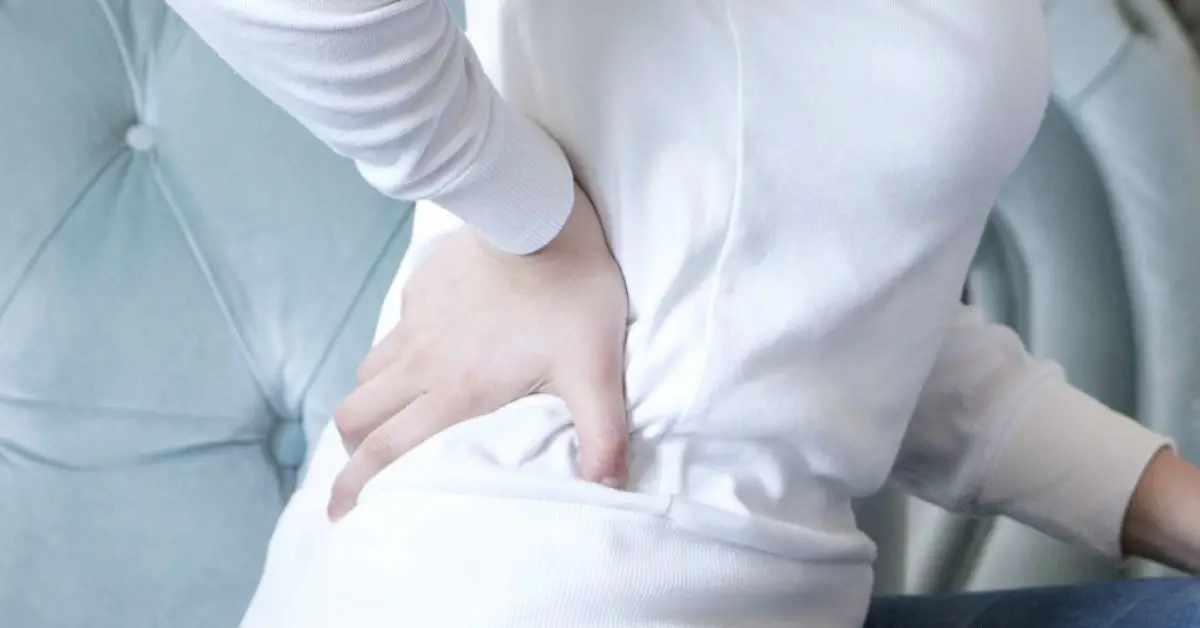Stretch And Strengthen Your Back
When you no longer have acute pain, you may be ready for gentle strengthening exercises for your stomach, back, and legs, and perhaps for some stretching exercises. Exercise may not only help decrease low back pain but also may help you recover faster, prevent reinjury to your back, and reduce the risk of disability from back pain.
Walking is the simplest and perhaps the best exercise for the low back. Your doctor or a physical therapist can recommend more specific exercises to help your back muscles get stronger. These may include a series of simple exercises called core stabilization. The muscles of your trunk, or core, support your spine. Strengthening these muscles can improve your posture, keep your body in better balance, and decrease your chance of injury.
When Should I See A Specialist About My Lower Back Pain
Low back pain often gets better on its own and recovery is often enhanced with over-the counter-pain killers, hot or cold compression packs, and gentle physiotherapy initially.Individuals with low back pain should seek medical attention in the following situations :
- Very severe pain especially pain to the mid-back around the rib cage
- Background history of cancer or recent unintended weight loss
- Difficulty walking or moving the legs
- Sensation of numbness or tingling in the legs
- Loss of bowel or bladder function
- Loss of sensation in the legs
- Pain that is not improving
- If back pain is associated with other concerning symptoms such as abdominal pain
- Back pain associated with fever
- Recent severe trauma such as falling from a height
When To See A Rheumatologist For Your Back Pain
Back pain is one of the most common reasons for seeking healthcare. But what type of healthcare provider should you see for your back pain?
Usually, you would start with your primary care provider. Most of the time, they will diagnose and effectively treat your back pain. You might be advised to use at-home therapies , prescription medication, or go to physical therapy. If you have a chronic disease, injury, or if you aren’t getting better, you may be referred to a rheumatologist.
Rheumatologists are physicians who specialize in diagnosing and treating certain inflammatory disorders, including inflammatory diseases of the joints, such as arthritis.
Less often, you may be referred to an orthopedist, which is an orthopedic surgeon. For example, you might need orthopedic intervention for severe osteoarthritis, a common type of arthritis caused by wear-and-tear damage.
This article helps you understand when you should see a rheumatologist for your back pain, and the differences between rheumatologists and orthopedists.
- People of all ages, races, and genders
Also Check: Is Motrin Good For Back Pain
How Is Low Back Pain Diagnosed
A complete medical history and physical exam can usually identify any serious conditions that may be causing the pain. Neurologic tests can help determine the cause of pain and appropriate treatment. Imaging tests are not needed in most cases but may be ordered to rule out specific causes of pain, including tumors and spinal stenosis. Occasionally the cause of chronic lower back pain is difficult to determine even after a thorough examination.
Tests include:
Blood tests are not routinely used to diagnose the cause of back pain but might be ordered to look for signs of inflammation, infection, cancer, and/or arthritis.
Bone scans can detect and monitor an infection, fracture, or bone disorder. A small amount of radioactive material is injected into the bloodstream and collects in the bones, particularly in areas with some abnormality. Scanner-generated images can identify specific areas of irregular bone metabolism or abnormal blood flow, as well as to measure levels of joint disease.
Discography involves injecting a contrast dye into a spinal disc thought to be causing low back pain. The fluids pressure in the disc will reproduce the persons symptoms if the disc is the cause. The dye helps to show the damaged areas on CT scans taken following the injection.
Electrodiagnostics can identify problems related to the nerves in the back and legs. The procedures include:
Which Type Of Doctor Should I Visit For Lower Back Pain

From temporary aches to disabling chronic pain, lower back pain affects millions of people each year. According to the National Institute of Neurological Disorders and Stroke, about 80% of people will experience lower back pain at some time in their lives. There are many kinds of back specialists, so if you’re asking yourself, “Which type of doctor should I visit for lower back pain?,” you’ll want to read on.
Recommended Reading: Aleve Lower Back Pain
Common Causes Of Back Pain
Two of the most common reasons for back pain are muscle strains or ligament sprains. and bad posture can put on your back and make it hurt. and other changes in your spine as you get older can cause back pain. More serious causes of the condition include a ruptured disc or . Possible causes of back pain include:
-
, when the soft center of spinal disc slips out of place
-
, a disease that thins and weakens bones including the vertebrae
-
, a bone infection
-
, arthritis in the spine
-
Sacroiliitis, inflammation of the joint between the pelvis and lower spine
How Is Back Pain Treated
Acute back pain usually gets better on its own. Acute back pain is usually treated with:
- Medications designed to relieve pain and/or inflammation
- analgesics such as acetaminophen and aspirin
- non-steroidal anti-inflammatory drugs such as ibuprofen and naproxen may be sold over the counter some NSAIDS are prescribed by a physician
- muscle relaxants are prescription drugs that are used on a short-term basis to relax tight muscles
- topical pain relief such as creams, gels, patches, or sprays applied to the skin stimulate the nerves in the skin to provide feelings of warmth or cold in order to dull the sensation of pain. Common topical medications include capsaicin and lidocaine.
Exercising, bed rest, and surgery are typically not recommended for acute back pain.Chronic back pain is most often treated with a stepped care approach, moving from simple low-cost treatments to more aggressive approaches. Specific treatments may depend on the identified cause of the back pain.
Recommended Reading: Back Pain Cleveland Clinic
Start With A Physiatrist
Unless you need to see a primary care provider for a referral, Dr. Dowdell suggests visiting a physiatrist as your first step. A physiatrist is the primary care doctor of the back, he explains. are fully focused on diagnosis and non-surgical treatment of musculoskeletal issues, so they may have more specialized knowledge than a PCP. Even if youve already told your family doctor about your back pain, its a good idea to talk to a physiatrist nextespecially if whatever youve been trying isnt working.
What Can Cause Lower Back Pain
Most acute low back pain is mechanical in nature, meaning that there is a disruption in the way the components of the back fit together and move. Some examples of mechanical causes of low back pain include:
Congenital
- Skeletal irregularities such as scoliosis , lordosis , kyphosis , and other congenital anomalies of the spine.
- Spina bifida which involves the incomplete development of the spinal cord and/or its protective covering and can cause problems involving malformation of vertebrae and abnormal sensations and even paralysis.
Injuries
- Sprains , strains , and spasms
- Traumatic Injury such as from playing sports, car accidents, or a fall that can injure tendons, ligaments, or muscle causing the pain, as well as compress the spine and cause discs to rupture or herniate.
Degenerative problems
- Intervertebral disc degeneration which occurs when the usually rubbery discs wear down as a normal process of aging and lose their cushioning ability.
- Spondylosis the general degeneration of the spine associated with normal wear and tear that occurs in the joints, discs, and bones of the spine as people get older.
- Arthritis or other inflammatory disease in the spine, including osteoarthritis and rheumatoid arthritis as well as spondylitis, an inflammation of the vertebrae.
Nerve and spinal cord problems
Non-spine sources
Read Also: Back Pain Advil
Emotional Support Is Important
You may have to lean on friends and family when facing difficult situations caused by chronic pain or other problems. Your loved ones can play an important role in supporting your recovery. Your doctor and community also may give you extra support.
Asking for support from others is not always easy. It can be hard to tell someone about your problems. But don’t be afraid to ask for help.
Where you can get support
- Family. Family members can help you cope by giving you comfort and encouragement.
- Friends. Building strong relationships with others is important for your emotional well-being. Helping is a big part of friendship. At times you may be the one who encourages a friend.
- Counselling. Professional counselling can help you cope with situations that interfere with your life and cause stress. Counselling can help you understand and deal with your pain. You can learn ways to stop negative thoughts. See the topic Stop Negative Thoughts: Choosing a Healthier Way of Thinking.
- Stop Negative Thoughts: Getting Started
How friends and family can help
Specialists Who Treat Back Pain
There are many types of health practitioners that care for patients with spinal conditions, and each has a slightly different role. Selection of the most appropriate type of health professional – or team of health professionals – largely depends on the patient’s symptoms and the length of time the symptoms have been present.
The different types of health professionals who treat back pain tend to have varied training and interests. While it is common to start off with a primary care provider , if the patient’s back pain is resistant to initial treatment then the services of a spine specialist may be necessary.
Recommended Reading: Advil Vs Ibuprofen For Back Pain
Who Should Treat Your Back Pain
Many types of medical professionals treat back pain, and each has different training, skills, and specialties. So how do you know which specialist is best for helping to alleviate your back pain? Heres an overview of different back pain specialists and which type or team may be right for you.
See:Specialists Who Treat Back Pain
Why Is Lower Back Pain Such A Common Problem

The bottom part of your back typically has just five vertebrae fewer than your neck and mid-back. And these vertebrae do a lot of heavy lifting! Your lower back is where your spine connects to your pelvis, bearing the weight of your upper body. This area experiences a lot of movement and stress, which may lead to wear, tear and injuries.
You May Like: Advil Or Ibuprofen For Back Pain
How Is Lower Back Pain Diagnosed
Your provider will ask about your symptoms and do a physical exam. To check for broken bones or other damage, your provider may order imaging studies. These studies help your provider see clear pictures of your vertebrae, disks, muscles, ligaments and tendons.
Your provider may order:
- Spine X-ray, which uses radiation to produce images of bones.
- MRI, which uses a magnet and radio waves to create pictures of bones, muscles, tendons and other soft tissues.
- CT scan, which uses X-rays and a computer to create 3D images of bones and soft tissues.
-
Electromyography to test nerves and muscles and check for neuropathy , which can cause tingling or numbness in your legs.
Depending on the cause of pain, your provider may also order blood tests or urine tests. Blood tests can detect genetic markers for some conditions that cause back pain . Urine tests check for kidney stones, which cause pain in the flank .
Emergency Room Healthcare Providers
The emergency room is often the go-to destination for people with neck or back pain who need immediate medical attention. This may be due to trauma from car accidents, falls, or gunshot wounds.
Symptoms of cauda equina syndrome, which include loss of bowel or bladder function, or your legs grow progressively weaker, are also reasons to seek emergency care.
If you don’t actually need to see a healthcare provider immediately, it’s best to schedule an appointment with your provider’s office.
Don’t Miss: Advil For Lower Back Pain
When Its Severe Pain
If your pain is severe and ongoing, its time to see a specialist such as an orthopedist or a physical medicine and rehabilitation doctor, which is sometimes called a physiatrist, Dr. Gordon says.
An orthopedist is a surgeon who is devoted to the prevention, diagnosis and surgical and non-surgical treatment of disorders of the musculoskeletal system your bones, joints, ligaments, tendons and muscles.
Some orthopedists are generalists, while others specialize in certain areas of the body such as hip and knee, foot and ankle or shoulder and elbow, Dr. Gordon says.
A physiatrist is a medical doctor who has completed training in the specialty of physical medicine and rehabilitation and may be subspecialty certified in other areas, such as brain injury medicine, neuromuscular medicine or sports medicine.
Physiatrists focus treatment on function and treat the whole person, not just the problem area. They have broad medical expertise that allows them to treat disabling conditions throughout a persons lifetime.
Can Lower Back Pain Be Related To Weather
If you feel like your lower back pain worsens on days when its cold or the weather is changing, you are not imagining things. Back pain can indeed be related to barometric pressure and outdoor temperature. Changes in pressure can sometimes cause pain in arthritic joints, including the spine. Muscles and joints in general react to the environment, which can make them stiffer and more likely to suffer an injury.
Also Check: Will Naproxen Help Back Pain
What Happens When I Visit A Back Doctor
We gather a full medical history of your back problems and perform detailed physical examinations, said Dr. Guo. That includes checking for tenderness, spine range of motion, strength, sensation, and reflexes. Depending on your symptoms, we may perform provocative tests to find out what triggers your pain. We may order imaging studies, such as X-rays, MRIs, or CT scans. We may order electromyography and a nerve conduction study, which assess whether you have muscle and/or nerve problems that may cause your symptoms. We use all the information to help identify the cause of your back pain and associated symptoms, and provide the most appropriate treatments for you.
Who Will Likely Refer You To A Physical Therapist
Generally, the first course of action for ongoing back pain is six weeks of physical therapy, plus at-home treatments like those mentioned earlier in the article.
can also do assessments of how youre sitting, standing and movingand show you how to improve your workspace and posture, for instance. And theyll create an exercise or movement program thats designed to help your back feel better.
Read Also: Advil Or Aleve For Back Pain
When Should I See A Doctor For Back Pain
When your back first starts to hurt, try taking an over-the-counter pain reliever and applying ice in the first 48 hours. You may apply heat after 48 hours. You may need to take it easy for a while, but its best to stay as active as tolerated, and to avoid absolute bed rest, said Dr. Guo.
If your back pain lasts more than two weeks and keeps you from participating in normal, daily activities, see your family doctor. If your pain is severe, you should see a doctor sooner. You should seek urgent medical care if you have:
- Fever associated with back pain
- Back pain after trauma
- Loss of bladder or bowel control
- Loss of strength in your arms and legs
- Unexplained weight loss associated with back pain
Also, always be more cautious if you have special risk factors for cancer, infection, or fractures that may affect the spine.
Can Lower Back Pain Be A Sign Of Something Serious Like Cancer

Lower back pain can be related to cancer. In fact, it is one of the first symptoms of prostate cancer when it metastasizes and creates lesions. Almost any cancer can spread to the back and some, like sarcoma, can originate in the back. Be cautious, especially if you are experiencing other symptoms besides lower back pain. Talk to your doctor if you have additional symptoms or concerns.
You May Like: Will Aleve Help With Back Pain
Other Conditions That Cause Back Pain In Older Adults
We often see a range of less serious but still painful spine conditions in seniors. Most patients with these conditions will not require surgery. Physical therapy, medication, injectable anesthetics, or a combination of treatments usually can control symptoms.
- Degenerative disc disease, which can cause whole spine pain, and lumbar arthritis, which usually causes low-back pain, commonly develop with age and are considered wear-and-tear conditions.
- Sacroiliitis is an inflammation of the joints that connect your spine and pelvis. This condition can cause pain in the low back, glutes, and upper legs.
- Ankylosing spondylitis is an inflammatory arthritis that causes patients spines to become inflexible, resulting in a continual hunched forward position and spine pain.
- We also check for adult degenerative scoliosis and kyphosis, spine-curving conditions that can result in back pain and weakness in the lower extremities.